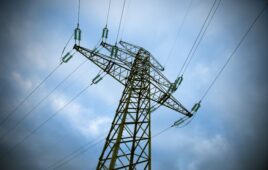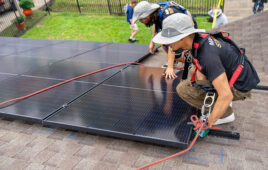 The new home building industry will have to make some major adjustments once the California Energy Commission’s new rule requiring solar to be installed on all new homes takes effect in 2020. Solar contractors that can offer a streamlined and simple installation solution that won’t interrupt the new building process will likely be the preferred choice of builders.
The new home building industry will have to make some major adjustments once the California Energy Commission’s new rule requiring solar to be installed on all new homes takes effect in 2020. Solar contractors that can offer a streamlined and simple installation solution that won’t interrupt the new building process will likely be the preferred choice of builders.
The California Building Industry Association wasn’t thrilled about the solar mandate, but realized it was going to happen regardless. So the nonprofit group worked with the California Energy Commission on behalf of the building industry to make the transition to mandatory solar as painless as possible.
“We wanted to push down on the compliance cost, and we wanted to make sure there was as much design flexibility in the adopted rates as possible, and we did that,” said Bob Raymer, technical director for CBIA. “We had a number of requests to the energy commission. They basically worked with us to resolve all of our requests, and ultimately we were able to support the adoption of the standard.”
The CBIA wasn’t supportive of the decision at the start because it thought a more pressing issue should’ve been fixed first—the affordable housing crisis in California.
“California ranks definitely at rock-bottom, No. 50, when it comes to housing affordability for first-time homebuyers,” Raymer said. “A whole lot of our builders focus on the entry-level housing.”
Although adding solar to a new home’s price won’t be a monumental expense, that additional amount could mean the difference between a person being able to qualify to build a home or not, Raymer said. However, he acknowledged that with time-of-use rates going into effect and raising electricity bills for Californians even higher, solar will be a welcome addition for many buyers.
“We found that about 60% of our homebuyers do have a strong interest in renewable energy,” Raymer said. “It’s one thing to say I like solar, it’s another thing to say I’m willing to pay for solar.”
Either way, the rules are final and CBIA is pleased with the outcome of the mandate after working alongside the CEC to make sure builders’ voices were heard.
CBIA said building companies will be looking for solar installers that will make adding solar to new homes as seamless as possible when the rule takes effect in 2020. Roofing companies that also install solar could be well-positioned to succeed in this role.
“As we head into 2020, the builders are going to be looking for simplicity,” Raymer said. “The more that you can get from what we call a turnkey operation—where you’ve got one contractor taking care of lots of stuff—that kind of takes the headache out for the builder and for the site superintendent that’s managing the construction of these 12 units here and these 15 units there.”
An integrated approach
Raymer doesn’t think most building companies will add solar to their company’s offerings; instead, they will contract out. One large builder has already added a solar arm, but smaller builders likely won’t have that capacity.
Lennar is the largest home building company in the country and has been offering solar to customers via its company SunStreet since 2006.
The company formed SunStreet because it didn’t find what it was looking for in the market.
“There is a fundamental mismatch between the way the solar industry is architected today—one-off installations—and the production-oriented platform that a homebuilder like us and frankly any of our peers would need in order to build on a production-line basis,” said David Kaiserman, president of Lennar Ventures and CEO of SunStreet.
Lennar prides itself on being on the forefront of installing new technology in its new homes. Solar is an important piece of that innovation, along with integrating new homes with built-in Wi-Fi and partnering with Amazon on home automation.
“For us, solar is part of the modern way of living, and it is part of the overall ‘technology fabric’ of how people live today,” Kaiserman said.
Lennar needed a solar solution that could integrate seamlessly into the building process. Instead of spending one full day to complete an entire installation, the company will install one piece of the solar project for multiple new builds when it makes sense. For example, one day it might install the solar wiring for a suite of homes. A week later it might be ready for rails, and so on.
The company founded SunStreet to provide that production-line solar service for Lennar, and now it provides new home solar installation services to other builders.
Kaiserman said Lennar is “very encouraged by our ability to meet the new mandate,” but isn’t commenting on whether the company supported it or not.
“I think home builders, as they get their sea legs underneath them, will realize that solar is part of the reason why people buy new,” Kaiserman said. “It will spark an interest around the country even if there’s no mandate in other states, that this is an opportunity to make the home a more modern, exciting proposition.”
Although the building industry wasn’t necessarily enthusiastic about the California solar mandate on new homes, builders will have to find the most cost-effective and streamlined ways to add solar—or risk falling behind.
Click here to learn how integrated solar+roofing companies are preparing to adjust to the new rule







Some builders are encouraging the solar movement because of the reputation they gain. When they are built in during construction, it is more affordable for many home owners and less hassle.
Developers can opt to build a solar farm (if they have room), instead of putting it on every roof. Ground mount systems are much cheaper to build and maintain and eliminate the issue of rooftop solar slowing/complicating the build process. We can also build carports, canopies, floating solar and PV windows. There are more options now than ever, so you don’t need to be stuck with a single choice. Centrally managed microgrids make more sense than point solutions for each house.
It seems almost no one is reporting on the fact that builders can meet the requirement by offering zero down leased solar systems through companies like Tesla and add $0 to their construction costs. We’ve been including solar on every home we’ve built for the past few years and they are a zero down lease unless the homebuyer decides to purchase and own the system. Overwhelming majority of our buyers stick with the zero down lease once they learn about the details, though.